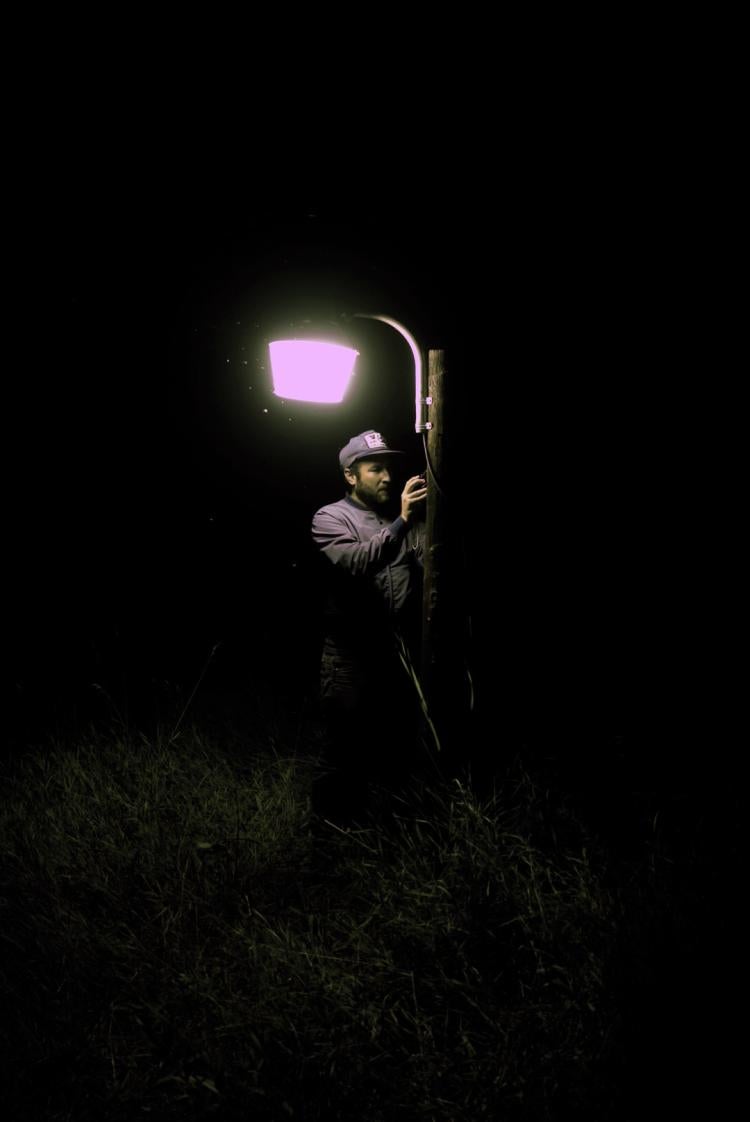Mountain art residency attracts participants like moths to a flame
New program aims to promote cross-disciplinary research between art and science, and to support new creative works

Aaron Treher appears in an image titled "Street Light Project: Piney Creek Site." Photo by Barbara Bosworth.
In a small, brightly lit cabin nestled in a mountain forest west of Boulder, moths and other night creatures rushed toward the mercury vapor streetlights glowing inside. After dark, hundreds of moths and insects of many varieties flew into the open door and swarmed around the lights as part of an art installation conceived by Aaron Treher, who is a contemporary artist.
Treher, who earned a Master of Fine Arts in art practices at the University of Colorado Boulder, is the first recipient of a residency program launched this summer to promote cross-disciplinary research between art and science, and to support new creative work by a selected artist-in-residence.
Treher’s project documented the interaction of bugs and streetlights in a gallery space.
The Mountain Research Station Sculpture Residency Program is a collaboration among sculpture and post-studio practice in the Department of Art and Art History at CU Boulder, the Mountain Research Station (MRS) and the Institute of Arctic and Alpine Research (INSTAAR). The residency includes the use of two remote MRS cabins, one for the artist to stay in for two weeks and the other to use as a studio or gallery space.
“I’ve been wanting to do this project for a long time,” Treher said.

An insect alights on a street lamp in Aaron Treher's work at the Mountain Research Station.
“The point of the work was to get people to look at these older style streetlights and consider them as cultural objects while also seeing how they interact with the ecology of a place. People reacted in an excited way and MRS is a great space for that kind of work. I had some great conversations with researchers and students about the intersection between art and science.”
The point of the work was to get people to look at these older style streetlights and consider them as cultural objects while also seeing how they interact with the ecology of a place."
Treher’s art practice focuses on building, documenting and studying forms of architecture and infrastructure that serve as niche habitats for specific animal species, such as barn swallows and bats. His artworks utilize sculpture, photography, architectural design, fieldwork and ecological survey.
“We think of street lights in terms of public safety,” Treher said. “The type of streetlights I’m working with have also become a form of habitat for a specific set of animals. I’ve been trying for a long time to find a place that would allow me to document the interaction of bugs, bats and streetlights. Most gallery spaces wouldn’t be too happy about hundreds of bugs showing up in their space. This residency was a perfect opportunity for me to make that happen.”
The residency program is directed by Richard Saxton, professor in art practices at CU Boulder.
“The main point of the residency is to create relationships between science and art,” Saxton said. “We really believe an artist needs to be working deeper in other fields, not just art, so we’re pushing hard to produce what we think of as the next generation of artists and cultural leaders. That includes being able to understand science topics like climate change and have first-hand experience with it. We’ve dedicated ourselves to that engagement with the world.”
The concept of a sculpture is much wider than people give it credit for, Saxton said. In Treher’s piece, the sculpture involved using the entire cabin.
“When we talk about sculpture, we’re also talking about installation art, outdoor participatory art,” Saxton said.
An important aspect of this residency is interacting with the classes and researchers at the MRS and creating work that can engage audiences that include K-12 students, undergraduates and graduates, and researchers who come from around the world.

Street lamps are visible inside of a cabin at the Mountain Research Station, where Alex Treher's creation underscores the interplay between the human-built environment and indigenous creatures, in this case insects. `
The residency program is one way that the sculpture and post-studio practice area promotes cross-pollination with scientists, researchers and policy makers whose work centers on rural environments, conservation and ecology. The residency allows space for creative voices to join many important science-based conversations.
The artists-in-residence will share their work through open studio events and presentations. Immersed in the workings of a science research station, artists can create site-specific installations, ecological projects, walking and hiking projects and collaborative experiments.
The residency will be awarded annually to an alumnus or graduating Masters of Fine Arts students in the CU Boulder sculpture and post-studio practice area. Artists will spend two weeks during the summer on the MRS campus.
At 9,500 feet in the Front Range of the Colorado Rockies, MRS is an interdisciplinary INSTAAR research centerdevoted to the study of mountain ecosystems. Alpine ecosystems support an abundance of diverse and rare species that are being affected by climate change. For nearly 100 years, MRS has provided research and educational opportunities for scientists and students.
“We want to continue offering more than just the studio on campus,” Saxton said. “We’re really focused on site-based work. There may be some preliminary research they’ve done, but the project is going to come out of their time there.”

